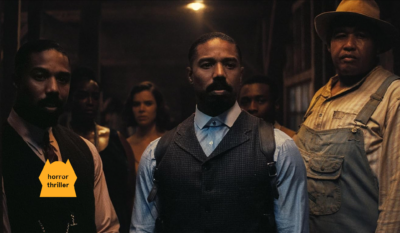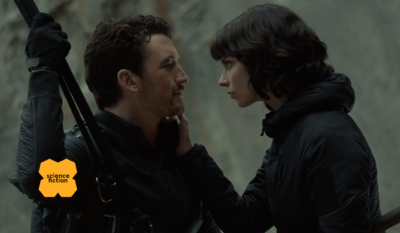Avatar: The Way of Water returns us to the world of Pandora where the Navi's struggle against human colonizers takes them to the water


Avatar: The Way of Water reminds us that the possibilities of film are endless as it expands the world of Pandora to an impossibly stunning underwater landscape. Coupled with James Cameron's inability to direct a bad action scene, it's an immersive sci-fi epic that keeps you engaged from start to finish. That's despite a derivative plot and underdeveloped characters. While other movies might feel empty by relying on its visuals, The Way of Water emotes through them. Did I care for any of the characters (or know their names)? Nope. Do I care what happens in the sequels? Absolutely not. But it's an enjoyable 3-hour visual magnum opus. ![]()

After the release of Avatar in 2009, there was a spate of news stories about people feeling depressed after seeing the movie. They couldn't live with the fact that they didn't live in a world as beautiful as Pandora apparently. I had a similar experience when I went to the bathroom during the long three-hour runtime of the movie's sequel Avatar: The Way of Water. As I sprinted out of the theater, the dull colors of the AMC Empire (if you know you know) and the quiet of the halls felt deafening. As I came back into the theater, feeling encompassed by the world felt comforting. But do I now remember the names of any of the characters on the screen? Absolutely not.
ADVERTISEMENT
That was always the clap back from the original's detractors, especially those defending The Hurt Locker's Best Picture win at the Oscars. The challenge was to name three characters or one iconic line to prove the movie's cultural impact and staying power (typically the challenge would end at “Jake Sully”). It was always interesting considering the sheer scale of the movie. Director James Cameron created an entire world, culture, and famously, language for the movie similar to George Lucas with Star Wars. But unlike that long-running franchise, nothing from the Avatar world has seemed to stick. I mean, you don't walk around saying “I see you” to people, which would have been the answer to that earlier question.
But as I was sitting watching Avatar: The Way of Water I wondered if that was not a bug, but a feature.
What better way to make people focus on some of the most incredible and impressive CGI visuals created for film than to make every other element fade into the background to simply support it. Do I need to know the name of Jake Sully (Sam Worthington) and Neytiri's (Zoe Saldaña) second son? No. (It's Lo'ak if you're wondering). But did I tear up while he was comforting his whale-like companion? Absolutely. It's what James Cameron does best. He emotes through his visuals. Of course there are countless iconic lines in Titanic, but the images of Jack and Rose standing on the bow of the ship or getting steamy in a car are what really sell the romance. The Way of Water does the same. Instead of romance, however, Cameron emphasizes family.
ADVERTISEMENT
We're reintroduced to Jake and Neytiri more than a decade after the events of the original movie through sweaty expositional voiceovers. Despite pushing out the “sky people” aka colonizing humans aka the Resource Development Administration (I know…) from Pandora, they've returned more aggressively than ever destroying the clan's home and driving them into hiding. The humans, led by General Frances Ardmore (Edie Falco), are bent on taking over the planet as a recolonization effort for humanity. However, the Navi are fighting back and slowly cutting off the RDA's supplies which is why Ardmore brings in reinforcements in the form of Colonel Miles Quaritch (Stephen Lang) who returns after being killed by Neytiri during the events of the first film as an Avatar with the memories of his human form.
The Sullys fly off to a distant island chain where the Metkayina clan is settled. Though they're wary of the family at first, leader Tonowari (Cliff Curtis) and his wife Ronal (Kate Winslet) allow them to stay granted they assimilate with the people. And while it treads similar ground to the original, the way the Metkayina expand the lore of the Avatar world is nothing short of awe-inspiring. Unlike the forest-dwelling Omaticaya clan where the family is from, the Metkayina live off of the water. Because of that, their tails and arms have fish-like fins while their skin is a lighter shade of blue.
The Metkayina's trepidation toward the outsiders mirrors Neytiri and her clan's reaction to Jake's arrival in the first movie. Here, however, it's their children—Neteyam (Jamie Flatters), Lo'ak (Britain Dalton), Tuktirey (Trinity Jo-Li Bliss), and adopted Kiri (Sigourney Weaver returning to play the daughter of her original character)—that bear the brunt of the assimilation as Tonowari and Ronal's kids Reya (Bailey Bass) and Aonung (Filip Geljo) train them in the “way of water.” In the same way that their home tribe relies on and is connected to the forest, they are connected to the ocean and its creatures. This is where Avatar: The Way of Water soars (swims?). Like the first movie (or any other of Cameron's movies), the world-building is unmatched. For an hour, we're treated to some of the most impressive visuals I have ever seen on screen as the world of Pandora is expanded into the water.
ADVERTISEMENT
After more than a decade of muddy CGI-gobblygook where the worlds have no weight or permanence (*head slowly turns to Marvel and DC*), seeing what the VFX artists were able to create has raised the bar. And it's not even the sweeping landscapes that are the most impressive like in the first movie—though those are impressive, as well. It's the close-ups. In some scenes, I would just stare at the texture of the skin of the Navi. There are imperfections, just like in life, in every frame that make you feel immersed in this new world. Unlike Black Panther: Wakanda Forever, where there was much to be desired from the underwater kingdom of Talokan, The Way of Water takes its time to explore every facet of this new foreign land.
And sure, a lot of the plot beats that it hits are derivative like Reya and Lo'ak's burgeoning romance or a confrontation with a group of boys who don't take to the outsiders. But setting it in this detailed tapestry of a world negates any quibbles I could have with the plot. Like in one of the most impressive sequences of the movie, Lo'ak is attacked by a shark-like beast after being left in the deep water by some nefarious teens from the village. He is saved by a whale-like creature called a Tulkun, a spiritual partner to the clan, and begins to bond with it. While the “two outcasts bonding over being outcasts” story is familiar, the sheer visual of “man” and beast together is enough to draw you in.
ADVERTISEMENT
However, whenever we spend time with the human characters, particularly Colonel Quaritch and his biological son Spider (Jack Champion), who has lived with the Navi since the events of the first movie before being kidnapped by his newly resurrected Avatar father (I know this plot is convoluted), the movie loses a lot of the awe that distracts us in other scenes. The humans are drawn so black-and-white that they're almost evil for the sake of being evil. Although Quartritch does have possibly the most defined arc of any of the characters and when both storylines crash together it leads to a satisfying (and thrilling) conclusion that is possibly one of the best large-scale action scenes I've seen in years.
Avatar and now Avatar: The Way of Water will always be fascinating entries in James Cameron's filmography. From Aliens to Terminator 2 to Titanic, he has been able to weave together compelling stories with pure spectacle. Avatar excels incredibly in the latter and just barely passes on the former. However, the way it excels makes it almost impossible not to enjoy yourself for its surprisingly spry three-hour runtime.
ADVERTISEMENT
More movies, less problems
- Jordan Peele Unleashes the First Trailer for ‘HIM'
- ‘Sinners' is the best movie of the year | movie review
- Romantic sci-fi thriller ‘The Gorge' hits its mark | movie reivew
Hey! I'm Karl. You can find me on Twitter and Letterboxd. I'm also a Tomatometer-approved critic.
💌 Sign up for our weekly email newsletter with movie recommendations available to stream.
ADVERTISEMENT
Hey, I'm Karl, founder and film critic at Smash Cut. I started Smash Cut in 2014 to share my love of movies and give a perspective I haven't yet seen represented. I'm also an editor at The New York Times, a Rotten Tomatoes-approved critic, and a member of the Online Film Critics Society.

